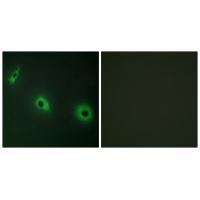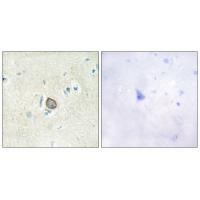

| WB | 咨询技术 | Human,Mouse,Rat |
| IF | 咨询技术 | Human,Mouse,Rat |
| IHC | 1/50-1/100 | Human,Mouse,Rat |
| ICC | 1/100-1/500 | Human,Mouse,Rat |
| FCM | 咨询技术 | Human,Mouse,Rat |
| Elisa | 咨询技术 | Human,Mouse,Rat |
| Aliases | Cadherin EGF LAG seven-pass G-type receptor 3 ; Flamingo homolog 1; hFmi1; Multiple epidermal growth factor-like domains 2; Epidermal growth factor-like 1 |
| Entrez GeneID | 1951; |
| WB Predicted band size | 360kDa |
| Host/Isotype | Rabbit IgG |
| Antibody Type | Primary antibody |
| Storage | Store at 4°C short term. Aliquot and store at -20°C long term. Avoid freeze/thaw cycles. |
| Species Reactivity | Human |
| Immunogen | Synthesized peptide derived from internal of human CELSR3. |
| Formulation | Purified antibody in PBS with 0.05% sodium azide. |
+ +
以下是3篇关于CELSR3抗体的参考文献及其摘要概括:
---
1. **文献名称**: "CELSR3 regulates neurodevelopment through planar cell polarity signaling in radial glial cells"
**作者**: Li X, et al.
**摘要**: 本研究利用特异性CELSR3抗体在小鼠模型中揭示了CELSR3通过平面细胞极性(PCP)通路调控放射状胶质细胞极性与神经元迁移的机制,为神经发育障碍提供潜在分子机制。
---
2. **文献名称**: "Prognostic significance of CELSR3 expression in colorectal cancer identified by immunohistochemical analysis"
**作者**: Wang Y, et al.
**摘要**: 通过免疫组化(使用CELSR3抗体)发现结直肠癌组织中CELSR3高表达与患者不良预后相关,提示其可作为肿瘤侵袭性的生物标志物。
---
3. **文献名称**: "CELSR3 modulates Wnt/β-catenin signaling in pancreatic ductal adenocarcinoma"
**作者**: Chen L, et al.
**摘要**: 研究采用CELSR3抗体进行Western blot和免疫荧光实验,证明CELSR3通过调控Wnt/β-catenin通路促进胰腺癌细胞的增殖和转移,为靶向治疗提供新方向。
---
以上文献均明确使用CELSR3抗体进行蛋白表达或功能研究,涵盖神经发育、癌症机制及临床相关性。
The CELSR3 (Cadherin EGF LAG Seven-Pass G-Type Receptor 3) antibody is a research tool targeting the CELSR3 protein, a member of the non-clustered protocadherin subfamily within the cadherin superfamily. CELSR3. also known as Flamingo homolog, is a key player in planar cell polarity (PCP) signaling, critical for tissue morphogenesis, neural development, and organ patterning. It functions as a transmembrane receptor, interacting with Wnt ligands and other PCP components like FZD3 and VANGL to regulate cell alignment, migration, and polarity during embryonic development.
CELSR3 antibodies are widely used in neuroscience, developmental biology, and cancer research. In studies, they help detect CELSR3 expression in tissues (e.g., brain, heart) or cell lines via techniques like Western blot, immunohistochemistry, or immunofluorescence. Dysregulation of CELSR3 has been implicated in neurodevelopmental disorders (e.g., neural tube defects), cardiovascular anomalies, and cancers (e.g., glioblastoma, breast cancer), where its role in cell adhesion and signaling pathways is explored.
Commercial CELSR3 antibodies are typically raised in hosts like rabbits or mice, validated for specificity against human, mouse, or rat isoforms. Researchers prioritize antibodies with minimal cross-reactivity to homologous proteins (e.g., CELSR1/2). Challenges include optimizing protocols due to CELSR3's low tissue abundance and complex membrane localization. Recent studies also investigate its interaction with the tumor microenvironment and non-canonical Wnt signaling, highlighting its therapeutic potential.
×